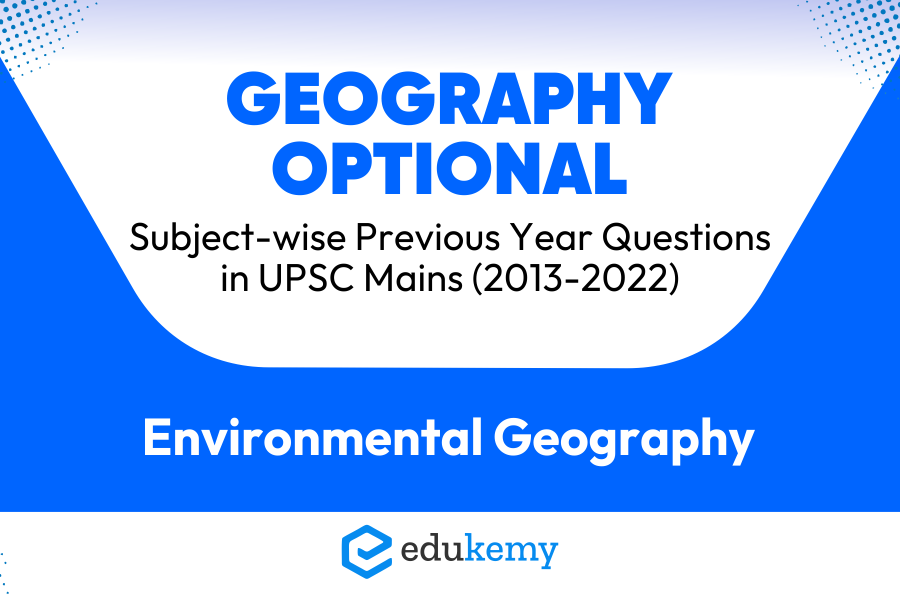Environmental geography is a branch of geography that studies the relationship between humans and the natural environment. It examines how humans interact with the physical and biological elements of the environment and the impact of human activities on the Earth’s natural systems.
Environmental geography focuses on a wide range of issues, including climate change, pollution, land use, resource depletion, and biodiversity loss. It looks at how these issues are distributed across the globe, and how they are influenced by social, economic, and political factors.
Environmental geographers use a variety of research methods, including fieldwork, remote sensing, and geographic information systems (GIS), to analyze environmental data and understand spatial patterns and relationships. They work to develop solutions to environmental problems, such as sustainable land use practices, renewable energy technologies, and conservation strategies.
Environmental geography is a highly interdisciplinary field that draws on insights from natural sciences, social sciences, and humanities. It is an essential component of efforts to promote sustainable development and mitigate the environmental impacts of human activities. By providing a comprehensive understanding of the complex interactions between humans and the natural environment, environmental geography helps us to make informed decisions about how to manage our planet’s resources and protect the Earth’s ecosystems for future generations.
Get the Geography Optional Hard Copy Notes of Shabbir Sir’s most recent batch: Here
Environmental Geography Previous Year Questions (UPSC CSE Mains Geography Optional)
- What are the high-altitude environmental hazards? Explain with suitable examples. (10 Marks/2022)
- Sequential changes in land use and land cover have brought global and regional ecological changes and imbalances. (20 Marks/2022)
- Plants and animals that exist in a particular ecosystem are those that have been successful in adjusting to their habitat and environmental conditions. Elucidate with examples. (20 Marks/2022)
- Describe how ecosystem services of Himalaya are essential for Highland-I sustainability in Asia. (10 Marks/2021)
- Explaining the concept of carbon neutrality, describe the measures taken by carbon-positive and negative nations. (15 Marks/2021)
- With suitable examples, elaborate human ecological adaptations. Explain its impacts on ecology and environment in various parts of the world. (20 Marks/2021)
- Discuss the problems associated with the living environment in million plus cities in India. How can these the managed? (10 Marks/2020)
- Discuss the human response to and management of hazards and disasters in India. (15 Marks/2020)
- “Human ecology is the study of mutual relationship of people and their environment both natural and social.” Discuss in detail using ecological concepts. (15 Marks/2020)
- Amensalism is a biotic factor that determines the geographic limits of species. Explain. (10 Marks/2019)
- How do mountaineers constitute a threat to Mount Everest? (10 Marks/2019)
- Why is it necessary to conserve genetic diversity of species? Do protected areas serve any useful purpose in this context? (20 Marks/2019)
- “The web of life is seamless and the consequences of disruption to one part of the ecosystem ripple throughout the whole.” Elaborate. (15 Marks/2019)
- The impact of floods on life and property can be most effectively reduced by hazard mapping. Comment. (15 Marks/2019)
- Explain the natural and anthropogenic causes and mitigation measures of frequent flooding in Mumbai. (10 Marks/2018)
- Discuss the objectives and principles of environmental education. Describe the basic concerns of formal and non-formal environmental education in India. (15 Marks/2018)
- “Controlling population growth is the sustainable solution to environmental problems.” Express your views with suitable arguments. (15 Marks/2018)
- Explain the ecosystem approach to environmental management and highlight its advantages and disadvantages. (15 Marks/2018)
- Discuss the Perception, Attitude, Value and Emotion (PAVE) Theory of environmental management. (15 Marks/2017)
- Explain the hydro-meteorological hazards in the Himalayas. (10 Marks/2016)
- Give a reasoned account on how the impact of global warming differs from one part of the Earth to the other. (15 Marks/2016)
- Write a critical note on the tendency of “use and throw” in the context of economic status and environment. (15 Marks/2016)
- Discuss the major characteristics of ‘CBD’. (10 Marks/2016)
- Explain the characteristics of ecological succession. (10 Marks/2015)
- Comment on the impact of environmental education on quality of life. (10 Marks/2015)
- Discuss the method of conserving biodiversity for sustainable development. (15 Marks/2015)
- Explain the different stages of ecological adaptation of man and bring out the changing balance between man and environment. (20 Marks/2015)
- Give an account of the nature of biosphere as an ecosystem. (10 Marks/2014)
- Enumerate the major causes of increasing degradation of environment in hills and hillslopes, and state its down-valley impact. (15 Marks/2014)
- Write short note: Uniqueness of fauna in the Notogean realm. (10 Marks/2013)
- What are the characteristics that make CHC a serious threat to the ecosystem? Give examples. (15 Marks/2013)
- Explain the levels of Noise pollution and legislative measures to control it. (25 Marks/2013)
- “Ellen Churchill Semple is an ardent supporter of Determinism.” Explain. (10 Marks/2013)
Frequently Asked Questions (FAQs)
1. What are the key themes covered under Environmental Geography in the UPSC Mains Geography Optional Subject, based on the previous year questions from 2013 to 2022?
Previous year questions in Environmental Geography have consistently covered a range of topics such as climate change, biodiversity, natural resources, environmental degradation, and sustainable development. Understanding the recurring themes can help aspirants prioritize their preparation and focus on essential areas.
2. How has the emphasis on Environmental Geography evolved over the years in the UPSC Mains Geography Optional Subject?
Analyzing the trend of questions from 2013 to 2022 provides insights into the changing dynamics of the Environmental Geography section. Observing shifts in the focus areas can assist candidates in adapting their preparation strategies to align with the evolving pattern and expectations of the UPSC examiners.
3. Can you provide examples of interdisciplinary connections within Environmental Geography as reflected in the previous year questions for UPSC Mains Geography Optional Subject?
Environmental Geography often intersects with other disciplines. Previous year questions may demonstrate connections with subjects like ecology, economics, and geopolitics. Recognizing these interdisciplinary links is crucial for a holistic understanding and effective response to questions that require an integrated approach.
4. How have case studies been utilized in the Environmental Geography section of UPSC Mains Geography Optional Subject in the past decade?
The inclusion of case studies in questions reflects the application of theoretical knowledge to real-world scenarios. Aspirants should examine how case studies have been used in previous years to enhance their ability to provide practical, context-specific solutions to environmental challenges.
5. What is the significance of current affairs and contemporary issues in Environmental Geography based on the UPSC Mains Geography Optional Subject Previous Year Questions (2013-2022)?
The UPSC often incorporates current affairs and contemporary issues into the Environmental Geography section to test candidates’ awareness of ongoing environmental challenges. Aspirants should analyze how recent events and developments have influenced the framing of questions and be prepared to integrate current information into their responses for a comprehensive understanding.

For UPSC Prelims Resources, Click here
For Daily Updates and Study Material:
Join our Telegram Channel – Edukemy for IAS
- 1. Learn through Videos – here
- 2. Be Exam Ready by Practicing Daily MCQs – here
- 3. Daily Newsletter – Get all your Current Affairs Covered – here
- 4. Mains Answer Writing Practice – here
Visit our YouTube Channel – here


